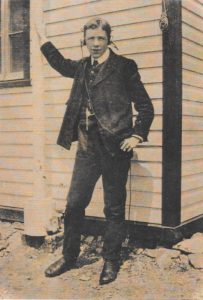Marconi Operators
The wireless stations of Newfoundland and Labrador are no longer operational. Many have since been torn down or repurposed. Their legacy lives on, however, through the stories of the men and women who kept the stations running.
Being a Marconi operator was no simple task. Operators had to be trained and acquire licenses, they worked long thankless hours, and they sometimes had to move their entire lives to a new community to fill a position.
Not only that, but the work came with a great deal of pressure. Operators never knew what to expect when a message came in. It could be a weather report, a personal message, or a distress signal from a ship sinking with thousands of people on board. No matter what it was, they had to be ready. While some people took the job more seriously than others, there is no doubt that these operators held a great deal of responsibility in their communities.
This page shares a few more details about some of the operators and their stories.
Stan Brazill
Stan Brazill ran the Battle Harbour Marconi wireless station from 1912 to 1949. He hosted a radio program called “Brazill’s Broadcast,” which aired during the 1930s and ’40s. His program was heard all over Labrador, earning Stan the nickname “King of Labrador.” He devoted so much of his life to radio that his two sons, Earl and Stanley Jr., followed in his footsteps and also became Marconi operators.
J.J. Collins
James J. Collins joined the Canadian Marconi Company in 1904. During his time with the CMC, he was in charge of no less than eight different stations around Eastern Canada and in the Dominion of Newfoundland. In 1915, he became the superintendent of the CMC in Newfoundland and Labrador. He helped build stations, install Marconi devices on ships, and inspected various Newfoundland and Labrador stations. He was also in charge of negotiating with the government of Newfoundland on behalf of the CMC.
Joseph Butler
Joseph Butler operated the Makkovik wireless station in northern Labrador after the First World War. In 1932, he was hired to build the transmitter for the public radio station VONF (Voice of Newfoundland), which was owned by the Newfoundland government. After the government took over all other radio stations and established itself as the only major radio station in Newfoundland, Butler co-founded VOCM (Voice of the Common Man) in 1936. VOCM was created to combat the radio takeover and give a voice to the general public. The government tried to buy VOCM, too, but Butler and his colleagues refused, preventing a monopoly on public media. VOCM still operates to this day.
The Myricks
The Myrick family of Cape Race has something of a legacy themselves. Francis and Margaret Myrick began operating the lighthouse in Cape Race in 1874, thirty years before a wireless station was added. Several of their children became telegraph station operators and later wireless station operators. In fact, when the wireless station was built at Cape Race in 1904, their son Edward J. Myrick was one of the first wireless operators to run it. John Myrick was the head operator of the station during the First World War.
Myrick family members who could not get positions at the Cape Race station wound up running other stations or joining the CMC directly (Marconi operator James J. Collins married Margaret Myrick). The original wireless station building at Cape Race was lost over time, but a replica was built near the original site. It is aptly named “The Myrick Wireless Interpretation Centre.”


